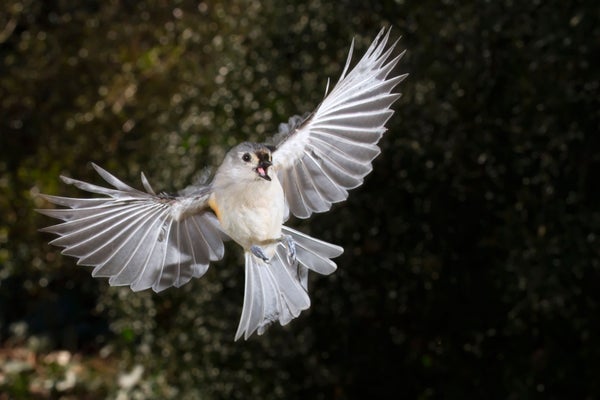Serious athletes and brawling schoolyard children are familiar with the audience effect: people compete harder in front of a crowd. This phenomenon is not unique to humans. Other mammals, birds, fish and even insects fight more vigorously when they know they are being watched by members of their own species.
In a surprise twist, however, this propensity does not just occur among friends and family. It turns out that the audience effect can kick in even when the onlookers belong to a different species from the fighters. According to findings published in April in Ecology and Evolution, the bigger and more diverse the audience of birds, the more intensely tufted titmice and Carolina chickadees turned up the heat on aggressive territorial displays when battling a member of their own species. Given that there is safety in numbers, the study authors suspect that a crowd of feathered neighbors, even ones of different species, lends peace of mind to battling birds that their bickering will not wind up getting them eaten by a predator.
“When the audience builds up, and predation risk lessens, the birds trash-talk more loudly and clearly,” says senior study author Katie Sieving, an avian behavioral ecologist at the University of Florida. “That makes the most sense to us because predation risk is an all-powerful concern for small birds 100 percent of the time.”
On supporting science journalism
If you're enjoying this article, consider supporting our award-winning journalism by subscribing. By purchasing a subscription you are helping to ensure the future of impactful stories about the discoveries and ideas shaping our world today.
Titmice and chickadees are the chatterboxes of the forest community, constantly vocalizing complex, content-rich calls that express what they see and how they feel in the moment, from exultant to fearful. “They’re like a little temperature meter; they never shut up,” Sieving says. Other species have evolved to tune into these calls to glean information about food, predators and territories.
Across her career studying these dynamics, Sieving has noticed that birds of different species often seem interested in one another’s fights. She finally had the opportunity to investigate that observation with the help of her former graduate student Jin Bai, who is now at North Carolina State University. Bai walked around suburban woods in Gainesville, Fla., and two nearby natural areas, searching for chickadees and titmice that were quietly foraging. Using a loudspeaker, he played an eight-minute recording of calls escalating in aggression that were made by one of the two species. Bai recorded a targeted individual’s response and also took notes about how many birds of other species were present. The gatherings could be impressive, with 12 to 15 other species, including cardinals, blue jays and woodpeckers, competing for branch space to watch the display. After the playback concluded, he took measurements of noise, wind, weather, vegetation density, habitat type and other factors to be controlled for in the study.
In an analysis of 134 playback sessions, Bai, Sieving and their colleagues found that both the number of birds and the diversity of species in attendance influenced both chickadees’ and titmice’s level of aggression. But Sieving says the effect was especially pronounced in titmice, which really went all out in the presence of an audience. If no other birds were watching, titmice usually sang a few times and flew up to the speaker once or twice and then called it quits. If others showed up for the spectacle, however, they sang a lot more, came closer to the speaker, and spent more time investigating it and flying back and forth.
“This is a very interesting article that opens up avenues of research not previously considered,” says Eben Goodale, a behavioral ecologist at Guangxi University in China, who was not involved in the study. “It also shows how continuing research over many years, and gaining more and more understanding of a study system, keeps opening windows into the life of nonhuman animals.”
Sieving is already delving deeper into the data for a follow-up study that gets at the question of why the audience effect holds in the presence of different species. “We are testing the hypothesis that the audience effect may influence how the fighters yell, basically,” she says.
Titmice use two different types of aggression calls: a quiet “flutter,” which is likely too high-pitched for predatory hawks to hear, and a bellowing “squeal,” which is more complex and combative but loud enough to potentially attract danger. If the audience effect is driven by predation, then the researchers would expect to see more of the whisperlike flutter call when fighters are alone and the ready-to-rumble squeal when other birds are present. Preliminary results confirm this hunch, Sieving says.
As for why individuals of other species like to watch titmice and chickadee throwdowns, Sieving says it is possible that they are extracting some sort of useful information about the quality of the territory the birds are squabbling over. On the other hand, the answer could simply be that they like to watch. “Birds are nosy, always wanting to spy on their neighbors,” Sieving says.
